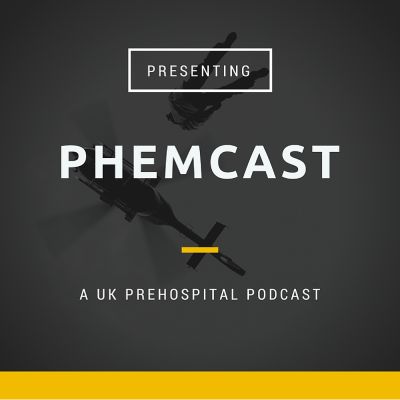A UK Prehospital Emergency Medicine Podcast. This podcast and associated website aims to: - Share knowledge and expertise in the field of prehospital medicine with specific reference to the UK working environment - Make this content relevant to all professional prehospital practitioners
https://phemcast.co.uk
Episode 11: Gentle Patient Handling
https://phemcast.files.wordpress.com/2016/07/final-gentle-patient-handlig.mp3
The paper we mentioned by Jonathan Benger and Jules Blackham can be accessed here:
https://sjtrem.biomedcentral.com/articles/10.1186/1757-7241-17-44
Stable versus unstable spinal injuryThe location of an injury and involvement of different structures defines the stability of a spinal injury.
Anterior column: anterior longitudinal ligament and the anterior half of the vertebral body/disc.
Middle column: posterior half of the vertebral body/disc and the posterior longitudinal ligament.
Posterior column: facet joints, ligamentum flavum, the spinous processes and the interconnecting ligaments.
An injury involving only the anterior column is considered to be stable, as will an isolated fracture of a spinous or transverse process. An unstable injury is one which involves all 3 columns and often one in which 2 columns are disrupted.
References- Stiell IG, Clement CM, McKnight RD, Brison R, Schull MJ, Rowe BH, et al. The Canadian C-spine rule versus the NEXUS low-risk criteria in patients with trauma. N Engl J Med. 2003 Dec 25;349(26):2510–8.
- Oteir AO, Smith K, Stoelwinder JU, Middleton J, Jennings PA. Should suspected cervical spinal cord injury be immobilised?: A systematic review. Injury. Elsevier Ltd; 2015 Apr 1;46(4):528–35.
- Smyth M, Cooke MW. Value of a rigid collar: in need of more research and better devices. Emergency Medicine Journal. 2013 May 13;30(6):516–6.
- Crane T, Cooke MW, Wellings R, Wayte S, Higgins J. MRI study of effectiveness of cervical spine immobilisation- a pilot study. The University of Warwick. 2007 Aug 1;:1–18.
- BOAST2: SPINAL CLEARANCE IN THE TRAUMA PATIENT. British Orthopaedic Association Standards for Trauma (BOAST); 2008. 1 p.
- Hauswald M, Ong G, Tandberg D, Omar Z. Out-of-hospital spinal immobilization: its effect on neurologic injury. Acad Emerg Med. 2008 Apr 15;5(3):214–9.
- Prasarn ML, Horodyski M, Dubose D, Small J, Del Rossi G, Zhou H, et al. Total Motion Generated in the Unstable Cervical Spine During Management of the Typical Trauma Patient. Spine. 2012 May;37(11):937–42.
- Gill DS, Mitra B, Reeves F, Cameron PA, Fitzgerald M, Liew S, et al. Can initial clinical assessment exclude thoracolumbar vertebral injury? Emergency Medicine Journal. 2013 Jul 19;30(8):679–82.
- Leech C, Porter K, Bosanko C. Log-rolling a blunt major trauma patient is inappropriate in the primary survey. Emergency Medicine Journal. 2013 Dec 22;31(1):86–6.
- Horodyski M, Conrad BP, Del Rossi G, DiPaola CP, Rechtine GR II. Removing a Patient From the Spine Board: Is the Lift and Slide Safer Than the Log Roll? J Trauma. 2011 May;70(5):1282–5.
- I J, A M, Yu E, Tulman D, Jones C, Stawicki S. A systematic review of the need for MRI for the clearance of cervical spine injury in obtunded blunt trauma patients afternormal cervical spine CT. Journal of Emergencies, Trauma, and Shock. 2014 Feb 11;7(4):251–5.
- Sundstrøm T, Asbjørnsen H, Habiba S, Sunde GA, Wester K. Prehospital Use of Cervical Collars in Trauma Patients: A Critical Review. J Neurotrauma. 2014 Mar 15;31(6):531–40.
- Armstrong BP, Simpson HK, Crouch R, Deakin CD. Prehospital clearance of the cervical spine: does it need to be a pain in the neck? Emerg Med J. 2007 Jul 1;24(7):501–3.
- PhD JRE, PhD JWS, OTD TLS, MSOT JLE, EMTP JSSM, MD RSN. Selected Topics: Prehospital Care. J Emerg Med. Elsevier Ltd; 2013 Jan 1;44(1):122–7.
- Connor D, Greaves I, Porter K, Bloch M, consensus group Faculty of Pre-Hospital Care. Pre-hospital spinal immobilisation: an initial consensus statement. Emerg Med J. 2013 Dec 1;30(12):1067–9.
- Fattah S, Johnsen AS, Andersen JE, Vigerust T, Olsen T, Rehn M. Rapid extrication of entrapped victims in motor vehicle wreckage using a Norwegian chainmethod – cross-sectional and feasibility study. 2014 Jul 3;14(1):1–5.
- Stiell IG, Nesbitt LP, Pickett W, Munkley D, Spaite DW, Banek J, et al. The OPALS Major Trauma Study: impact of advanced life-support on survival and morbidity. CMAJ. 2008 Apr 22;178(9):1141–52.
- Edwards MA, Verwey J, Herbert S, Horne S, Smith JE. Cervical spine clearance in the elderly: do elderly patients get a bad deal? Emerg Med J. 2013 May 23.
- Sundstrøm T, Asbjørnsen H, Habiba S, Sunde GA, Wester K. Prehospital Use of Cervical Collars in Trauma Patients: A Critical Review. J Neurotrauma. 2014 Mar 15;31(6):531–40.
- Shafer JS, Naunheim RS. Cervical spine motion during extrication: a pilot study. West J Emerg Med. 2009 May;10(2):74–8.
- Davis JW, Phreaner DL, Hoyt DB, Mackersie RC. The etiology of missed cervical spine injuries. J Trauma. 1993 Mar;34(3):342–6.
- Hale DF, Fitzpatrick CM, Doski JJ, Stewart RM, Mueller DL. Absence of clinical findings reliably excludes unstable cervical spine injuries in children 5 years or younger. Journal of Trauma and Acute Care Surgery. 2015 May;78(5):943–8.
- Benger J, Blackham J. Why do we put cervical collars on conscious trauma patients? Scand J Trauma Resusc Emerg Med. 2009;17(1):44.
